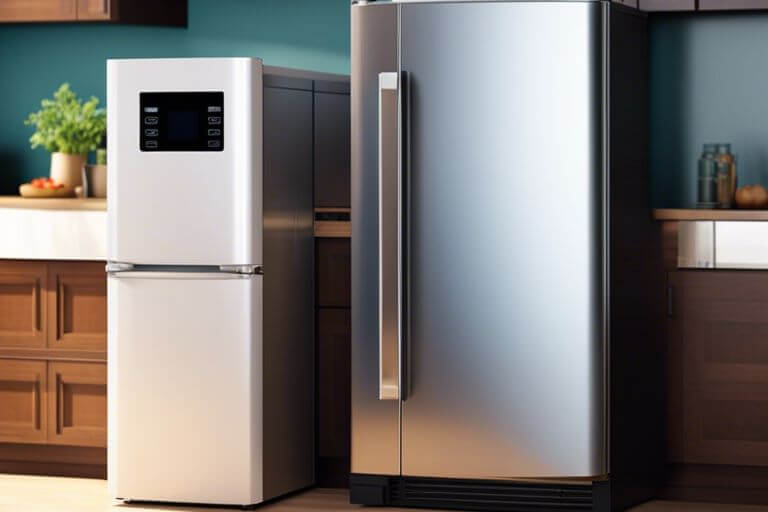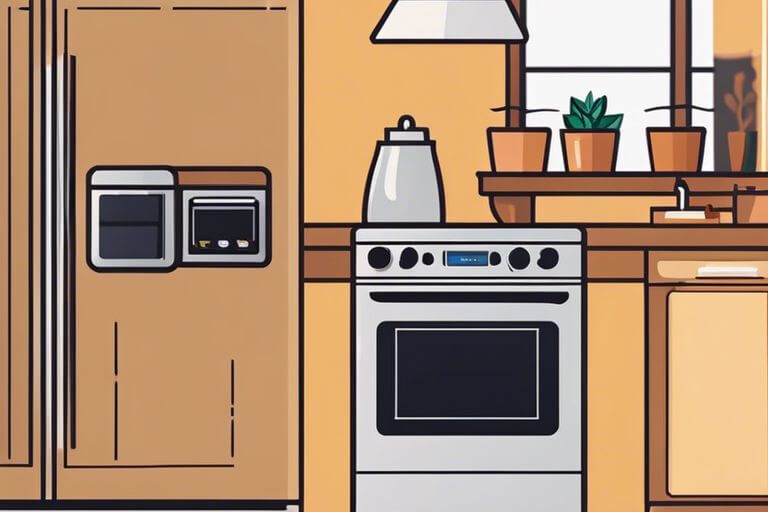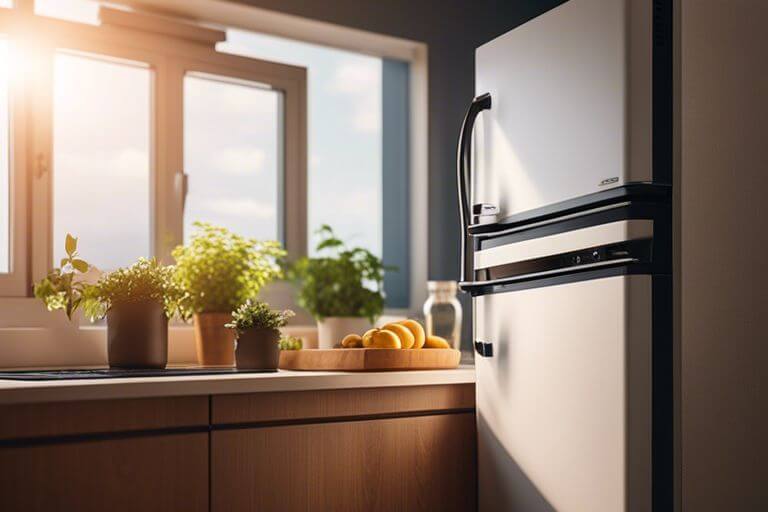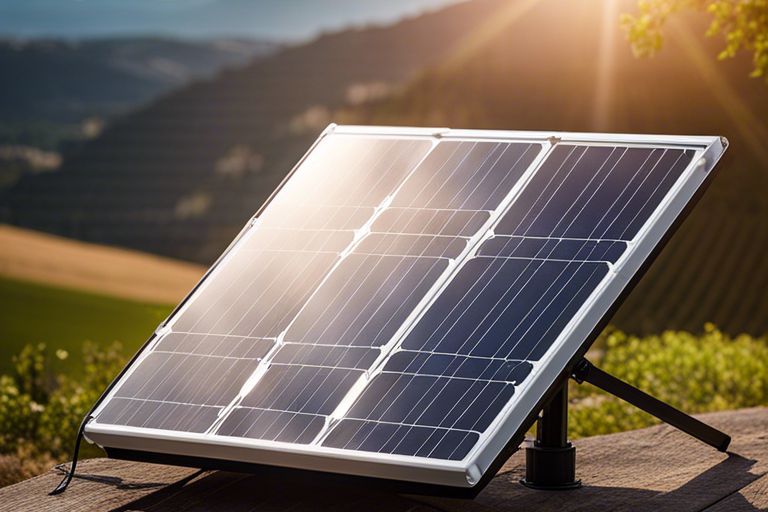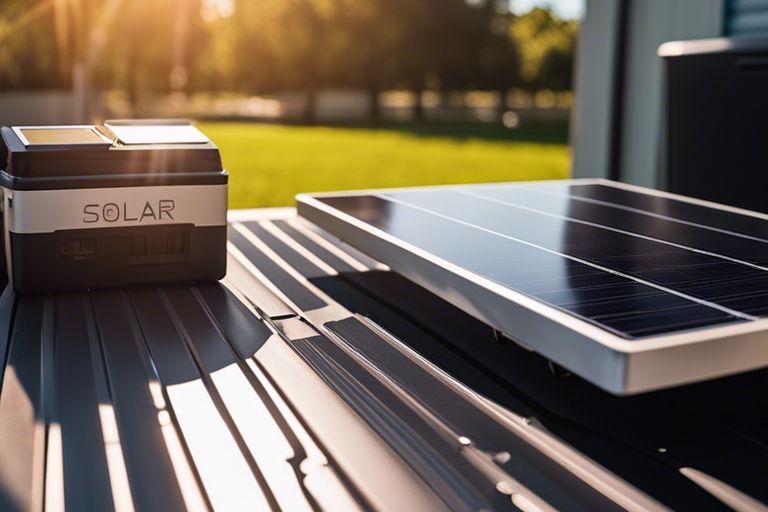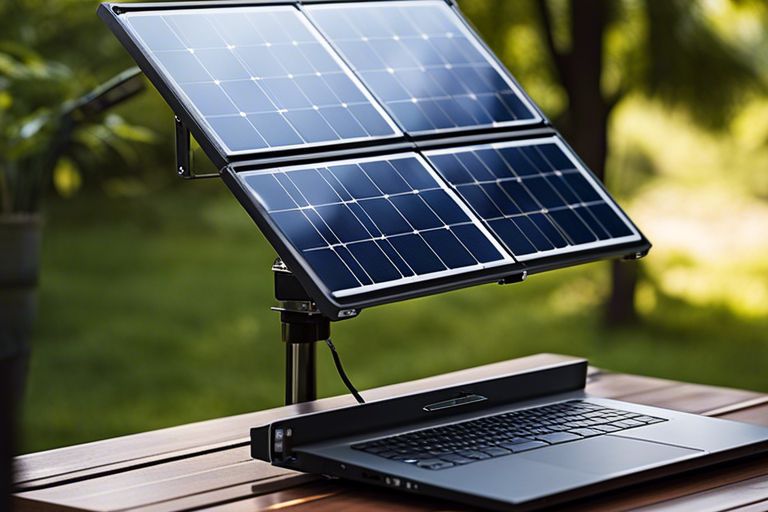Solar panels are a crucial component of your solar energy system, but understanding how many can be connected to your inverter is crucial for optimal performance. You need to consider factors such as the inverter’s capacity, the type of solar panels you have, and the energy needs of your home. The relationship between your inverter and solar panels directly impacts your system’s efficiency and energy output, so it’s vital to get this part right. In this post, we will break down the specifics to help you make informed decisions about your solar setup.
Key Takeaways:
- Inverter Capacity: The number of solar panels an inverter can handle is primarily determined by its power rating, usually measured in watts (W).
- Panel Wattage: Consider the wattage of the solar panels; for example, a 300W panel will affect how many can be connected to an inverter with a specific capacity.
- System Design: Proper system design is crucial; factors such as panel orientation and shading will also impact overall performance and inverter load.
- Efficiency Loss: Account for efficiency losses; it is typical to oversize the inverter to handle peak production without overloading.
- Regulations: Always check local regulations and manufacturer guidelines, as there may be restrictions on how many panels can be connected to a single inverter.
Understanding Solar Inverters
A solar inverter is a crucial component of any solar power system, as it converts the direct current (DC) electricity generated by solar panels into alternating current (AC) electricity that can be used in your home or fed back into the grid. By transforming the electricity, solar inverters ensure that your solar power system operates efficiently and effectively. The right inverter can significantly affect the performance and output of your solar energy system.
Definition of Solar Inverters
Understanding the definition of solar inverters is vital for anyone looking to invest in solar energy. In essence, solar inverters serve as the brain of a solar power system, managing how solar energy is produced, converted, and used. They monitor the energy produced by the solar panels and ensure that it is suitable for household consumption or grid sharing, thereby optimizing electricity usage.
Types of Solar Inverters
For you to fully harness the potential of solar energy, it’s important to be aware of the different types of solar inverters available. There are primarily three types: string inverters, microinverters, and power optimizers. Each type serves a unique function and offers various benefits that can help you optimize your solar energy system. Below is a breakdown of each type:
| Type | Description |
|---|---|
| String Inverters | Connect multiple solar panels in a series, ideal for uniform shading conditions. |
| Microinverters | Placed on individual solar panels, maximizing energy production from each panel. |
| Power Optimizers | Works similarly to microinverters but maintains a central inverter for conversion. |
| Hybrid Inverters | Can manage both solar energy and battery storage solutions, offering more flexibility. |
| Enphase Inverters | Leading brand of microinverters known for reliability and performance. |
- String inverters are often the most cost-effective option.
- Microinverters work exceptionally well in partial shading scenarios.
- Power optimizers can enhance the performance of string inverters.
- Hybrid inverters provide the versatility of battery backup.
- Knowing your specific energy needs can help you choose the right inverter type.
Inverters play a vital role in maximising solar energy production. Understanding their types allows you to make informed decisions on your system’s configuration, ensuring optimal electricity generation based on your unique circumstances. The right type of inverter can considerably enhance the efficiency of your overall solar power installation.
- Choosing between inverters should factor in space, budget, and energy requirements.
- Consider the warranty and lifespan associated with each type of inverter.
- String inverters are often more cost-effective for larger arrays.
- Microinverters can provide better performance over time.
- Knowing how each type might cope with your consumption patterns is key to selection.
| Key Function | Description |
|---|---|
| Conversion of Energy | Transforms DC electricity from panels to usable AC electricity. |
| Monitoring Performance | Tracks the energy production and health of the solar system. |
| Grid Connection | Manages the flow of electricity between the solar system and the grid. |
| Safety Features | Includes built-in mechanisms to protect your solar system from overloads. |
| Efficiency Management | Optimizes energy usage based on real-time data analytics. |
Key Functions of Solar Inverters
For you to appreciate the full capabilities of solar inverters, it’s vital to understand their key functions. One of the primary roles of a solar inverter is to convert the DC electricity generated by solar panels into AC electricity, which is what most household appliances use. Moreover, modern inverters are equipped with monitoring capabilities that track energy production, allowing you to analyze your system’s performance and make any necessary adjustments.
Optimizers also protect your solar panels by managing the electricity flow, ensuring your system operates safely. Furthermore, they allow you to feed excess electricity back into the grid, providing benefits like net metering credits. With the right inverter, you’ll be equipped to make informed decisions about your energy consumption while maximizing the efficiency of your solar energy system.
Factors Influencing Inverter Capacity
All the factors influencing the capacity of an inverter play a crucial role in maximizing the efficiency of your solar panel system. Understanding these elements is necessary to ensure that you select the right inverter for your specific setup, thereby optimizing energy production and performance. Here are several key factors to keep in mind:
- Size of the solar panel array
- Inverter specifications
- Environmental considerations
This understanding can significantly impact the longevity and efficacy of your solar investment.
Size of the Solar Panel Array
To effectively determine the number of solar panels an inverter can handle, you must first assess the size of your solar panel array. The overall capacity of your solar installation is defined by the wattage and number of panels. You can expect that the inverter should match or slightly exceed the combined wattage produced by the solar panels. Therefore, if you have an array of 20 solar panels, each with a capacity of 300 watts, the total output will be 6000 watts, which is an important benchmark for choosing your inverter.
Another consideration is how much power you will require to meet your energy needs. If your inverter is undersized, it may not be able to handle spikes in energy consumption or the peak performance of the solar array, leading to inefficiencies and potentially damaging the inverter. As a good rule of thumb, aim for an inverter that can accommodate at least 20% more than the total array output to ensure optimal performance.
Inverter Specifications
Capacity is another critical factor when assessing your inverter’s ability to handle solar panels. Each inverter comes with its specific ratings, including input voltage, output power, and the ability to manage several strings of solar panels. For instance, if your inverter supports a maximum input voltage of 600 volts and your solar panel system operates at a lower voltage, you are in safe territory. Additionally, assess how many strings of solar panels your inverter can accommodate since this determines how organized your setup can be.
A well-chosen inverter has the ability to handle both maximum power output and consistent energy generation. This means that when you explore the inverter specifications, pay attention to its continuous power output and peak efficiency ratings, as these influence how effectively the inverter converts the power coming in from your solar array. A high-quality inverter can ensure your solar energy system operates seamlessly and meets your energy demands.
Environmental Considerations
Specifications of the environment where your solar panels and inverter are installed also have a significant impact on inverter capacity. Factors like temperature fluctuations, humidity, and exposure to the elements can influence how well your inverter operates. Inverter cooling mechanisms can offset the thermal limitations imposed by heat, potentially allowing for higher outputs even in hot environments. It’s important to consider your local climate when planning your solar installation to select a suitable inverter.
Inverter models are often rated for specific operational environments. It’s wise to choose inverters that are designed for the climatic conditions in your area to ensure longevity and reliability. If you live in areas prone to extreme temperatures or humidity, opting for weather-resistant and robust inverter designs can mitigate performance issues in the future.
Calculating the Number of Solar Panels
For homeowners and solar enthusiasts alike, calculating how many solar panels your inverter can handle is crucial for optimizing your solar energy system. An inverter converts the direct current (DC) electricity generated by your solar panels into alternating current (AC) electricity for use in your home. Understanding the capacity of your inverter in relation to the output of your solar panels will help ensure you achieve maximum efficiency. You might also want to consider What is Solar Inverter Oversizing? as part of your planning to see if it’s applicable to your situation.
Determining System Size
Size is the first aspect you need to determine in calculating the number of solar panels you can connect to your inverter. Start by assessing your energy consumption needs and consider the kilowatt-hour (kWh) usage of your household. This can assist you in identifying the total system size you require. Once you have a calculator or chart ready, you’ll be able to make a more informed decision on how much solar energy you need to meet your demands effectively.
After determining your energy needs, you can also check the individual wattage of the solar panels you plan to use. This wattage is often listed in the specifications of the panel. By knowing both your energy consumption and the panel output, you can then determine how many panels you would need to effectively support your inverter.
Verifying Inverter Ratings
Panels play a significant role in understanding the capabilities of your inverter. Each inverter has a specific rating that indicates how much power it can handle at a given time, typically measured in watts (W). It’s crucial to match the total potential output of your solar panels to your inverter’s capacity to avoid overloading the system. If the total output of the panels exceeds the inverter rating, you could experience issues like overheating, reduced efficiency, or, in some cases, inverter failure.
Verifying the inverter ratings not only involves checking the maximum input power but also understanding its efficiency and performance characteristics. Read the manufacturer’s data sheets carefully, and don’t hesitate to reach out to them if you find some specifications unclear. Knowing your inverter’s total input capacity in relation to the potential output of your solar panels will help you make a more accurate calculation.
Safety Margins
Safety margins are crucial to ensure that your solar panel system operates efficiently and safely. Your inverter should not be operated at its maximum rating continuously, and having a safety margin allows for fluctuations in power output due to factors like shading, temperature changes, and equipment aging. A common rule of thumb is to keep the total wattage of your solar panels around 80% of your inverter’s capacity to preserve long-term reliability.
It is also wise to plan for future expansion of your solar system. If your energy needs grow or if you plan to add additional panels later on, leaving room in your inverter’s capacity can save you from costly replacements. Ensuring an adequate safety margin gives you peace of mind while optimizing the longevity and effectiveness of your solar energy system.
Overloading an Inverter
Unlike many other electrical components, your inverter has a specific capacity it can handle, and exceeding that capacity can lead to significant issues. It’s important to understand that overloading your inverter occurs when the total power output from your solar panels exceeds the inverter’s rated capacity. For example, if you have a 3 kW inverter, you may feel tempted to connect multiple solar panels that collectively produce more than that capacity. For guidance on determining how many panels you can connect, you can refer to this I have a 3 KW inverter and 550W panels, how do I decide … resource.
Risks of Overloading
Overloading your inverter poses several risks that you need to be aware of. First and foremost, there is a risk of damaging the inverter itself. When you push the inverter beyond its limit, it can lead to overheating, which may cause permanent damage, voiding any warranties you have. Additionally, the overload can result in frequent tripping, leading to system downtime. If your inverter is constantly shutting off to prevent damage, it defeats the purpose of harnessing solar energy in the first place.
Moreover, overloading can have cascading effects on your entire solar system. It may affect the performance of your solar panels, reducing their efficiency and resulting in energy loss. Not only does this impact your energy savings, but it may also lead to costly repairs that could have been avoided if the inverter had been properly sized from the start.
Signs of Overloading
To recognize if your inverter is being overloaded, you should look for specific signs that indicate distress. One of the most straightforward indicators is that the inverter frequently shuts down or trips, often displaying error codes. If you notice a pattern of interruptions in service, it might be a sign that your inverter is struggling to cope with the load placed on it.
Another sign of overloading is a noticeable decline in performance, such as a drop in output voltage or failure to produce the expected energy. You may find that your power generation figures are consistently lower than anticipated, which could indicate that your inverter can no longer manage the load demands placed on it.
Overloading can also manifest through unusual sounds, such as buzzing or clicking, which can indicate that the inverter is working excessively hard to manage the input power. Pay attention to these noise changes, as they can provide early warnings that your inverter is nearing its limit.
Mitigation Strategies
Inverter overloading can be mitigated through careful planning and system design. One of the most effective strategies is to ensure that your solar panel array is appropriately sized for the inverter’s capacity. This means calculating the total wattage of your solar panels and ensuring that it is within the safe operating range of your inverter. Monitoring your system regularly for changes in performance and adjusting the number of connected panels can also help prevent overloads.
Furthermore, consider investing in an inverter with a higher capacity if your energy needs have increased or if you plan to expand your solar panel setup in the future. This proactive approach can save you time and money in the long run, allowing you to harness more energy without risking the integrity of your system.
For instance, if you’ve recently acquired additional solar panels or experience seasonal increases in energy consumption, it may be beneficial to reassess the configuration of your existing system. Upgrading to a more powerful inverter can provide the necessary headroom for your energy needs, ensuring a consistent supply without sacrificing performance.
Recommendations for Solar Panel and Inverter Pairing
Many homeowners often wonder how many solar panels their inverter can handle and the best practices for pairing them effectively. An optimal pairing of solar panels and inverters is important for maximizing energy production and ensuring the longevity of your solar system. If your inverter is undersized, you may not fully harness the power your solar panels generate; if it is oversized, you could be wasting money. This section aims to guide you through the recommendations for solar panel and inverter pairing, ensuring you make informed decisions for your solar installation.
Best Practices for System Design
Solar system design is a crucial step that ensures your energy needs are met efficiently. To achieve this, it is advisable to calculate the total wattage of your solar panels and then match that with an appropriate inverter. A general rule of thumb is to have an inverter capacity that is between 80% to 125% of your solar panels’ capacity. This range accounts for energy losses that occur in the system while providing you a little wiggle room for optimal performance.
Additionally, consider your specific energy requirements and local weather conditions. Factors such as shading, temperature fluctuations, and orientation can affect solar panel output, so make adjustments accordingly. By taking these factors into account and carefully planning your system design, you can maximize energy capture effectively.
Choosing the Right Inverter for Your Panels
Recommendations for selecting an inverter should be based on the wattage of your solar panels, their type, and your long-term energy goals. You need to ensure that the inverter you select can handle the total output of your solar panel array. For example, if you have an array of 10 300-watt panels, your inverter should be rated between 2.4 kW and 3.0 kW to accommodate fluctuations and maintain efficiency.
Moreover, it’s important to consider the inverter’s features, such as its monitoring capabilities and whether it’s string, micro, or battery-based. Each type has its advantages, and selecting the one that aligns with your energy needs will make a significant difference in performance. Make sure to conduct thorough research or consult an expert to make the best choice for your unique setup.
Future-Proofing Your Solar System
The need for future-proofing your solar system cannot be overstated. As you invest in solar technology today, you want to ensure that your system can adapt to potential expansions or advancements down the line. This could mean choosing an inverter that can accommodate additional solar panels in the future or ensures compatibility with battery storage options as you consider energy independence.
Moreover, staying informed about the ever-evolving technology in the renewable energy sector will help you make adjustments as needed. Solar systems are a long-term investment, and taking steps to future-proof them will safeguard your energy production against both expected and unexpected changes.
System upgrades can include the addition of more panels, enhanced monitoring solutions, or even replacing existing components with newer, more efficient technology. Always aim for a scalable solution that allows you to expand your solar system as your energy demands grow.
Common Misconceptions About Inverter Capacity
Your understanding of the inverter’s capacity is crucial for optimizing your solar energy system. Many homeowners fall prey to misconceptions that can lead to inefficiencies or even damage to their systems. Being informed about these common misunderstandings can empower you to make better decisions regarding your solar setup.
Misunderstanding Power Ratings
Any time you look at an inverter’s specifications, you’ll see power ratings listed, often in watts. However, it’s common for individuals to misinterpret these numbers as a hard limit on the number of solar panels that can be connected. In fact, power ratings indicate the maximum power output, which does not directly translate to how many solar panels can be integrated. The actual number will depend on both the panel output and the inverter’s efficiency.
Additionally, many homeowners assume that they can simply add more panels until they reach this maximum rating. Yet, this approach ignores the inverter’s ability to handle peak loads and the necessity for systematic design to optimize performance. Understanding that rated capacity does not allow for efficient overloading is key to achieving the best result from your solar power system.
The Myth of Unlimited Connections
Ratings on solar inverters often give the false impression that you can connect as many panels as you like, as long as you’re under the stated power output. This leads to a misconception that exceeding the rated capacity is acceptable if you distribute loads wisely. However, overloading an inverter can lead to overheating and potential failure, making it imperative to adhere to the advised limits.
About 80% of inverter capacity is generally recommended for optimal performance. Exceeding this may create inefficiency, as the inverter struggles to manage power surges. So, when planning your installation, keep in mind that it’s not just about the total wattage of your solar panels; it’s also about maintaining your inverter’s longevity and functionality.
Importance of Professional Installation
Any attempt to self-install your solar system may lead to serious complications, particularly in regard to inverter capacity. Miscalculations and poor configuration can not only hinder the effectiveness of your solar power system, but they can also create safety hazards. Engaging a professional ensures that all components, including the inverter and solar panels, are properly matched and securely connected, thus preventing potential failures.
For instance, a professional installer will assess your home’s energy needs, evaluate the inverter’s maximum handling capability, and determine the optimal number of solar panels for your specific situation. Their expertise also extends to understanding local regulations and standards, which can save you from costly mistakes or fines later on. Ensuring that your installation is professionally handled will secure your investment for the long run.
To wrap up
As a reminder, understanding how many solar panels your inverter can handle is crucial for optimizing your solar power system’s efficiency. The capacity of your inverter, measured in watts, plays a significant role in determining the number of solar panels you can connect. By calculating the total output of your solar array and comparing it to your inverter’s specifications, you can ensure you are maximizing the energy generation potential while avoiding overloading your system. Proper planning and consideration can lead to increased savings and sustainability for your energy needs.
If you’re looking for a detailed guide on how to effectively determine the number of solar panels for your inverter, you can refer to the article on Determining the Numbers of Solar Panels for One Inverter. This resource will provide you with further insights, helping you make informed decisions about your solar power setup and ensuring it operates efficiently for years to come.
FAQ
Q: How do I determine how many solar panels my inverter can handle?
A: To determine how many solar panels your inverter can handle, you need to check the inverter’s power rating, typically measured in kilowatts (kW). You will also need to consider the wattage of the solar panels you plan to use. For example, if you have a 5 kW inverter and each of your solar panels is rated at 300 watts, you can calculate the maximum number of panels by dividing the inverter’s capacity by the panel wattage: 5,000 watts (inverter) / 300 watts (panel) = approximately 16.67. Since you cannot have a fraction of a panel, you can use up to 16 panels. Additionally, consider the temperature coefficient of the panels and the inverter’s efficiency rating for a more accurate setup.
Q: What happens if I connect too many solar panels to my inverter?
A: Connecting too many solar panels to a single inverter can lead to overloading, which can damage the inverter and result in decreased efficiency. Overloading occurs when the total output of the solar panels exceeds the inverter’s rated capacity, leading to overheating, shutdowns, and potential long-term failures. It’s crucial to adhere to the inverter’s specifications to ensure optimal performance and longevity. It’s also important to ensure that your inverter has a “sunny day” rating, which allows for brief periods of excess while typically tracking average conditions.
Q: Can I use multiple inverters for a larger solar panel system?
A: Yes, using multiple inverters is a common approach for larger solar panel systems. In this setup, the system can be designed with several inverters, allowing you to connect more panels overall. Each inverter can manage a specific number of panels, and this can enhance system performance and efficiency. Additionally, inverters can be networked together to provide monitoring and optimization across the entire array, improving energy production and reducing the risk of failures in case one inverter malfunctions.
Q: Are there different types of inverters, and do they affect the number of solar panels I can connect?
A: Yes, there are different types of inverters, and they do affect the number of solar panels you can connect. The most common types are string inverters, microinverters, and power optimizers. String inverters have a set limit on the number of panels they can support due to their centralized nature. Microinverters can be connected to individual panels, which allows unlimited scalability as they’re not bound by a single inverter’s capacity. Power optimizers work with string inverters to provide enhanced monitoring and can improve efficiency, allowing for a bit more flexibility in panel connections. Each type has its own installation considerations and limits, so understanding the specifics of your chosen system is crucial.
Q: How do shading and panel orientation affect the inverter capacity?
A: Shading and panel orientation significantly affect inverter capacity because they impact the overall output of the solar panel system. If some panels are shaded or oriented poorly, they may not produce their rated wattage, which can lead the inverter to operate below its capacity. It is imperative to optimize the layout and positioning of solar panels to maximize sunlight exposure throughout the day. Additionally, many modern inverters include features such as maximum power point tracking (MPPT) that adjusts to varying output from differently oriented or shaded panels to optimize energy production, allowing the system to take full advantage of available sunlight without necessarily needing more panels.



